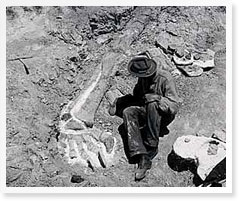Acquiring
If you love fossils or paleontology you may have wondered how museums acquire their collections, and how you might start a fossil collection of your own.
Museums use different methods to build their collections: the one that most people think of when we talk about collecting is excavation, but museums also obtain specimens through exchanges, loans, gifts, and even purchases. If you are a private collector, there are some locations where you are allowed to collect certain kinds of fossils; there are also some legitimate places where you can purchase fossils. However, there are also places where fossils are specially protected or where collecting is not permitted at all.
No matter how you acquire your fossils, it is essential that they are obtained legally. If you are collecting them yourself, then you almost certainly will need to obtain permission from someone first, whether a private landowner or a state or federal agency. If you are getting the fossils from someone else (as a gift or a purchase) then you need to be certain that person or organization had the appropriate permission to collect and that they have genuinely and legally transferred the specimen to your ownership through sale or donation.

It is especially important to have thought about why you are collecting and what sort of specimens you will collect. This will help you decide whether a specimen would be a good addition (i.e., does it help you build a deeper collection, maybe with a specialty in a certain kind of specimen, or does it add a kind of specimen that you are lacking?). In museums, these principles are usually set out as part of a collection policy. Where rare or scientifically important specimens are concerned, you should consider whether you are really the best person to care for the specimen and to make it accessible for study or whether it should be in an accredited museum or university collection.
In order to become an official part of a museum collection a specimen must be accessioned, which makes the museum the legal owner and responsible for the care and preservation of that fossil. Whether it is held in a public or private collection, having the right paperwork to record the history of discovery and acquisition of the specimen should be as important as the actual fossil itself. This information is known as the specimen’s provenance.
For more on these issues see the detailed information in this section:
For more information on what happens after a museum collects and accessions a fossil specimen, see the section on Storing.



